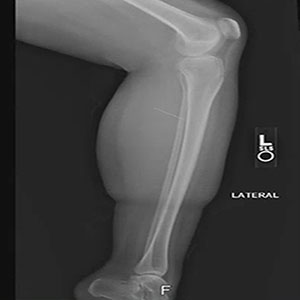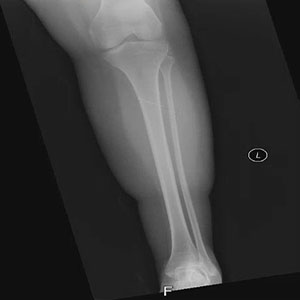Previous Issues Volume 2, Issue 1 - 2017
Case Report an Unusual Seizure-Related Injury in a Patient with Rett Syndrome: A Sewing Needle Foreign Body to the Leg
Alan Lucerna*, James Espinosa, Philip Carhart
Department of Emergency Medicine, Rowan University SOM, Kennedy University Hospital, Stratford, NJ, USA.
Corresponding Author: Alan Lucerna, Department of Emergency Medicine, Rowan University SOM, Kennedy University Hospital, Stratford, NJ 08084, USA, Tel: 856-346-7985; E-Mail: [email protected]
Received Date: 13 Mar 2017 Accepted Date: 15 Mar 2017 Published Date: 17 Mar 2017
Copyright © 2017 Lucerna A
Citation: Alan Lucerna, James Espinosa and Philip Carhart. (2017). Case Report an Unusual Seizure-Related Injury in a Patient with Rett Syndrome: A Sewing Needle Foreign Body to the Leg. Mathews J Emergency Med. 2(1): 022.
ABSTRACT
This case describes a 43-year-old female with Rett syndrome in whom a sewing needle was identified in her left leg after a seizure. The diagnosis was made based on the patient's inability to stand on the affected leg in association with a careful physical examination and ancillary imaging. The patients was admitted to the hospital. The sewing needle was successfully removed under anesthesia under fluoroscopic guidance. This case highlights the importance of a very careful physical exam and of additional history taking based on physical findings in a patient who has had a seizure. This is especially critical in the context of cognitive impairment, as was the case in this patient with Rett Syndrome. Based on a review of the literature, the patient presented in this case had an unusual seizure associated injury-a sewing needle penetration of her calf.
KEYWORDS
Seizure-Related Injury; Needle Injury to Leg Associated with a Seizure; Epilepsy-Related Injury; Sewing Needle Foreign Body to Leg Associated with a Seizure; Rett Syndrome; Injury Associated with Rett Syndrome with Seizures.
CASE PRESENTATION
A 43-year-old female with a history of cognitive impairment and seizure disorder, due to Rett Syndrome, was brought in by her mother to the Emergency Department (ED). The patient's mother provided a history of the patient experiencing difficulty bearing weight on her left leg after the patient had a seizure. The seizure occurred just prior to the patient's presentation to the ED. When attempting to stand, the patient would cry and would not bear weight on her left leg, even though clinically, there were no evidence of deformities or physical findings to preclude range of motion or weight bearing. The patient ordinarily could ambulate without difficulty. Her medications included Tegretol and Depakote. The physical exam was remarkable for a small puncture wound noted on the posterior aspect of the patient's left calf. The puncture wound area was tender to palpation. There was no focal weakness noted of her extremities. X-rays of the left leg revealed a metallic foreign body that was embedded in the deep aspect of the posterior calf. [Figures 1, 2] Additional history was then obtained. The patient's mother noted that the patient's seizure activity occurred next to the mother's sewing items. The patients was admitted to the hospital. A sewing needle was successfully removed under anesthesia, from the left calf, under fluoroscopic guidance.
Figure 1: Lateral view of the left leg demonstrates a radiopaque foreign body which appears to represent a needle in the deep soft tissue the calf behind the proximal tibia.
Figure 2: Frontal view of the left leg showing radiopaque foreign body consistent with a needle.
DISCUSSION
This case describes a 43-year-old female in which a sewing needle was identified in her left leg after a seizure. The patient had Rett syndrome. Rett syndrome was first described in 1966 by Dr. Andreas Rett, who reported 22 females with progressive regression of fine motor and communication skills, in association with cognitive impairment and other features. Approximately 80% of patients with Rett Syndrome have seizures. Almost all patients with Rett Syndrome are female. Mutations in the MECP2 gene, located on the X-chromosome were subsequently identified by researchers. Other mutations have also been identified [1, 2]. The patient had a penetrating injury with a sewing needle to her left calf. As a specific form of reported injury, this appears to be rare. Unusual isolated injuries related to seizures are found in the literature, such as an intracranial sewing needle in a child--likely sustained as an infant, through an open fontanelle, inadvertently, in a mother who was a seamstress and had sewing supplies throughout the house. Rust that developed on the needle may have caused the onset of seizures [3]. This case represents an unusual presentation of an epilepsyrelated injury. Injury-in-epilepsy research builds on a number of studies, with varying methodologies, inclusion criteria, lengths of study and conclusions. For example, an important and large study by Beghi et al prospectively looked at 951 referral patients with epilepsy of varying types and compared reported injuries with matched non-epileptic case controls. The study found a moderately higher risk of injury in epileptic patients than in the general population represented by the case control subjects. The most common injuries were contusions and wounds. Abrasions and fractures were the next most common injuries [4]. Lawn et al performed a retrospective study of 247 patients with seizures. The majority of injuries identified were minor head soft tissue contusions or lacerations. There was no control group in the design. Eight percent of injuries required hospitalization [5]. A recent population based study looked at data obtained from the Canadian Community Health Survey. This survey is crosssectional in design and studies such factors as health status and resource use in the Canadian population. Orthopedic injuries were the most frequent general category of injury. This study did not find an overall higher rate of injuries in people with epilepsy in comparison to the general population [6]. A study of seizure-related injuries in children and adolescents at a pediatric neurology clinic looked retrospectively at 125 patients with 125 age and gender matched case controls. The most common injuries seen were skin and soft tissue injuries, injuries to the soft tissues of the tongue and mouth, and dental injuries. Seizure frequency and multiple antiepileptic medications was associated with an increased rate of injury [7]. A number of reviews look at the international literature in reference to such issues as types of injuries in epilepsy, risk factors for injury in epilepsy and the degree of statistical association of epilepsy with motor vehicle accidents [8-10]. Based on a review of the literature, the patient presented in this case had an unusual seizure associated injury-a sewing needle penetration of her calf. The patient's mother provided a history of the patient experiencing difficulty bearing weight on her left leg after the patient experienced a seizure. The seizure occurred just prior to the patient's presentation to the ED. When attempting to stand, the patient would cry and would not bear weight on her left leg, even though clinically, there were no evidence of deformities or physical findings to preclude range of motion or weight bearing the patient ordinarily could ambulate without difficulty. This case highlights the importance of a very careful physical exam and of additional history taking based on additional findings in a patient who has had a seizure. This is especially critical in the context of cognitive impairment, as was the case in this patient with Rett Syndrome.
CONCLUSION
This case describes a 43-year-old female with Rett syndrome in whom a sewing needle was identified in her left leg after a seizure, based on the patient's inability to stand on the affected leg in association with a careful physical examination and ancillary imaging. The patients was admitted to the hospital. The sewing needle was successfully removed under anesthesia with fluoroscopic guidance. This case highlights the importance of a very careful physical exam and of additional history taking based on additional findings in a patient who has had a seizure. This is especially critical in the context of cognitive impairment, as was the case in this patient with Rett Syndrome. Based on a review of the literature, the patient presented in this case had an unusual seizure associated injury-a sewing needle penetration of her calf.
REFERENCES
- Percy AK. (2016). Progress in Rett Syndrome: from discovery to clinical trials. Wien Med Wochenschr. 166(11-12): 325-32.
- Leonard H, Cobb S and Downs J. (2016). Clinical and biological progress over 50 years in Rett syndrome. Nat Rev Neurol. 13 (1): 37-51.
- Balak N, Guclu G, Karaca I and Aksoy S. (2008). Intracranially Retained Sewing Needle in a Child: Does the Rust on the Needle Have any Implication? Eur J Trauma Emerg Surg. 34(2): 159-62.
- Beghi E, Cornaggia C and RESt-1 Group. (2002). Morbidity and accidents in patients with epilepsy: results of a European cohort study. Epilepsia. 43(9): 1076-83.
- Lawn ND, Bamlet WR, Radhakrishnan K, O'Brien PC, et al. (2004). Injuries due to seizures in persons with epilepsy: a population-based study. Neurology. 63(9): 1565-70.
- Tellez-Zenteno JF, Hunter G and Wiebe S. (2008). Injuries in people with self-reported epilepsy: a population-based study. Epilepsia. 49(6): 954-61.
- Lagunju IA, Oyinlade AO and Babatunde OD. (2016). Seizure-related injuries in children and adolescents with epilepsy. Epilepsy Behav. 54: 131-4.
- Nguyen R and Tellez Zenteno JF. (2009). Injuries in epilepsy: a review of its prevalence, risk factors, type of injuries and prevention. Neurol Int. 1(1): e20.
- Tomson T, Beghi E, Sundqvist A and Johannessen SI. (2004). Medical risks in epilepsy: a review with focus on physical injuries, mortality, traffic accidents and their prevention. Epilepsy Res. 60(1): 1-16.
- Wirrell EC. (2006). Epilepsy-related injuries. Epilepsia. 1: 79-86.

